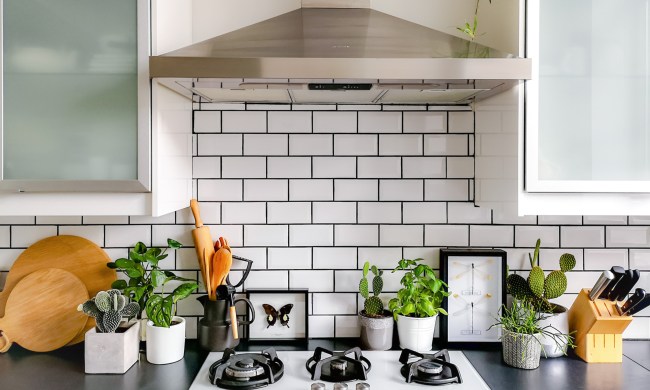Mediterranean interior design inspires tranquility, biophilia, and togetherness. This design style is ideal for those who enjoy entertaining and being one with the elements. If you’re wondering what exactly encompasses the Mediterranean style or want to implement these aesthetics in your home design, then we have everything you need to know.
What is Mediterranean home design?

Mediterranean home design is a warm, down-to-earth aesthetic popularized around the Mediterranean Sea. This interior design style often features white or cream stucco exteriors with red-tiled roofs, plenty of arches, and indoor-outdoor-styled courtyards or entryways. The style highlights earthy tones like cream, brown, green, or blue. Additionally, there’s an emphasis on a biophilic lifestyle and the utilization of patios, balconies, and other exterior entertainment spaces.
History of Mediterranean homes

Mediterranean styles found their way into many homes worldwide during the Mediterranean Revival in the 1920s. The style emerged from countries like Italy, Portugal, Spain, Morocco, and Greece. The idea of a villa home with open indoor-outdoor spaces, majestic arches, and a glamorous aesthetic became a necessity for many homeowners in other countries.
Mediterranean interior design vs. Mediterranean architectural design

The Mediterranean style is notable for many interiors and exteriors. Since the style favors indoor-outdoor design elements, it’s common to see Mediterranean influences both inside and out. However, you don’t have to have a Mediterranean-style exterior to introduce this aesthetic to the inside of your home.
Notable features of Mediterranean exteriors:
- Red- or brown-tiled roofs, often terracotta
- White or cream stucco exterior walls
- Plenty of decorative archways and half walls
- Inner and outer courtyard and patio spaces
- Balconies, patios, verandas, terraces, and gazebos are common
- Large windows for plenty of airflow
- Metalwork on windows, railings, and doorways
- Some homes also feature fountains or exposed wood beams for a natural touch
How to achieve the perfect Mediterranean home design

Whether you live in a stunning Mediterranean home or simply want to invite this aesthetic into your space, here are a few decorating tips to help you achieve the perfect look.
Focus on indoor-outdoor spaces
You don’t have to have Mediterranean architecture to pull off a gorgeous indoor-outdoor space. If possible, consider adding an attached covered porch or patio to your home with easy outdoor access. You can add sunrooms, verandas, or an ordinary patio space with large doors leading to your outdoor space.
Decorate this area with outdoor furniture for seating, fire pits, outdoor bars, and other entertainment features to make the space feel like an extension of the rest of the home.
Use a nature-inspired color palette
Mediterranean design uses nature-inspired color palettes. Most colors are neutral, and many tend to feel warm and airy. A white or cream exterior with brown or red details is a must. Add some more brown, beige, and tan hues indoors with a few accent colors like red, orange, blue, or green.
Warm accent colors are a must
While you’ll want to stick to a neutral or white backdrop in much of your Mediterranean-styled space, be sure to add some warm accent tones to the palette as well. Brown, red, burnt orange, and maroon are wonderful go-to hues for this design style.
Use natural elements in the design
Adding natural elements will further enhance the biophilic aspect of Mediterranean design. Opt for exposed wood beams wherever you can, or pepper your design with plenty of houseplants in ornate ceramic holders. Leaning into wool textiles, bamboo pieces, and sheer curtains can help invite natural elements that uplift the design.
Go for a minimal look with furniture
When choosing furniture for your space, it’s best to keep things minimal. Mediterranean decor should feel natural, laid back, and airy. Light touches of decor best suit this aesthetic. So, be sure to choose your pieces intentionally and avoid cluttering the space. You may need to invest in some optimized storage solutions to hide any unwanted clutter.
Patterned rugs and linens are best
Patterned rugs and linens add color, texture, and vibrancy to the design. Layering them can also create an organic look. Moroccan rugs are most common as they have unique, intricate patterns that blend beautifully with Mediterranean design. If your room feels bland, add a rug or patterned curtain to create more visual intrigue.
If you have large, open windows, we recommend choosing sheer white curtains for the perfect flowy look. Pair this with a bold, patterned rug for the best effect. If you’re dealing with limited floor square footage, you might opt to pull the eye upward with patterned curtains instead.
Use arches wherever you can
If you don’t mind some renovations, you can install rounded arches in your home in place of traditional doorways. An arched entryway is a classic Mediterranean look. Alternatively, you might consider installing a half wall around your home with an arched entrance or two for a classic courtyard look.
The Mediterranean style fuses the elements, inviting nature indoors to create an open, airy, and luxurious design. Add Mediterranean influences like Moroccan rugs, large windows, or architectural arches wherever possible to capture the perfect aesthetic.




